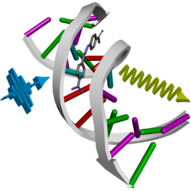
Ultrafast Spectroscopy
Photochemical reactions in the liquid phase often proceed via several intermediates, in  many cases these intermediates are very short-lived and the individual reaction steps are simply unknown. Our research interest is focused on such rapid light-induced processes, e.g. rearrangement or photolysis reactions, which we explore with time-resolved spectroscopy. We employ a variety of ultrafast spectroscopy techniques in order to unravel the photodynamics and underlying reaction mechanisms. For instance, the intermediates and products can be identified with ultrashort laser pulses in the mid-infrared by means of characteristic vibrational signatures. With our experimental setups, we can follow the light-induced reaction in real time.
many cases these intermediates are very short-lived and the individual reaction steps are simply unknown. Our research interest is focused on such rapid light-induced processes, e.g. rearrangement or photolysis reactions, which we explore with time-resolved spectroscopy. We employ a variety of ultrafast spectroscopy techniques in order to unravel the photodynamics and underlying reaction mechanisms. For instance, the intermediates and products can be identified with ultrashort laser pulses in the mid-infrared by means of characteristic vibrational signatures. With our experimental setups, we can follow the light-induced reaction in real time.
The following animation illustrates a "pump-probe experiment": a laser pulse, typically with a pulse duration in the femtosecond range, triggers the photoreaction. While the reaction proceeds short-lived intermediates are formed, which can be detected with a second laser pulse measuring the intermediate’s absorption. Since the time delay between the two laser pulses can be varied, one can directly observe after which time an intermediate is formed and when it reacts even further.

Moreover, we investigate if one can influence the course and the product distribution of a reaction in a well-defined way, e.g. by variation of the light employed in the experiments. For this purpose, ultrashort laser pulses exhibit remarkable properties, e.g. very high peak intensities, opening the possibility to interact with a molecule several times. Beyond that, the laser pulses are not monochromatic but are composed of a multitude of different colors, which can be delayed with respect to each other by means of a pulse shaper. Employing such shaped laser pulses, we explore whether the reaction can be steered in a desired direction, an experimental methodology which is often referred to as a "quantum control" approach.
The photochemical processes we currently study comprise reaction sequences of reactive species like radicals, molecular switching, charge- and energy-transfer processes, photoinduced structural changes and rearrangements, photolysis, and photoluminescence after an ultrafast intersystem crossing. In all of these cases, special emphasis is placed on the role of the solvent environment and the influence if cosolutes, e.g. for realizing bimolecular reactions relevant for photocatalysis.
For recent research highlights from our group, please have a look at the News section.

